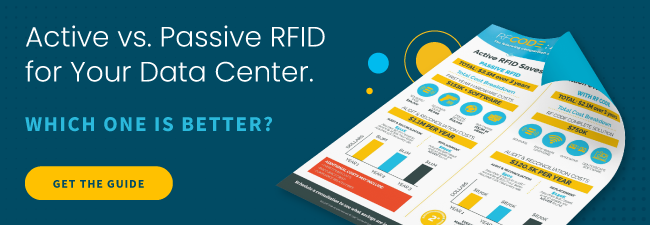Data center IT managers and engineers are facing increasing pressure to account for the location and condition of their critical assets. At the same time, they need to find ways to automate in order to do more with less, keep costs down, and maintain regulatory compliance. The question is – how are they supposed to juggle all of these responsibilities at once? Active RFID can help.
Active RFID asset tracking is the most cost-effective and powerful method to track and account for all critical data center assets over time anywhere in the data center, on and offline, enabling real-time audits, enhanced lifecycle management, and efficient environmental monitoring.
Before we dive into five active RFID use cases, let’s first start with the basics.
What is Active RFID?
Active radio frequency identification (RFID) refers to tags that are always-on, battery-fueled sensors used to collect and send data to a reader. In an active RFID setup, you'll find a reader, a tag, and an antenna working together.
Active RFID sends real-time information on IT assets, including environmental conditions and power use. RFID data collection will help you conduct automatic and accurate audits at a minute’s notice while also decreasing the cost of asset management—and potential risk.
Active RFID solutions address multiple operational challenges. You can instantly locate devices anywhere while continuously-updated dashboards and reporting provide detailed ambient insights. Should anything go awry, the system will alert you to unusual activity before it becomes a crisis.
The Five Active RFID Use Cases for Data Centers
Now that we're up to speed on how active RFID operated, let's look more closely at five active RFID use cases that showcase its potential.

1. Data Center Audits
Audits are necessary to understand your assets’ situation for financial and legal reasons. At the core, an important part of an audit is the process of ensuring that physical assets are where they should be. With error-prone and time-consuming methods like using spreadsheets or manual barcode scanners, you’re wasting resources that could be saved with automation.
RF Code’s active RFID reduces audit time and lost assets. RF Code’s wire-free sensors beacon the location of tagged assets every 30-60 seconds automatically including those assets that are not connected to the network. It is like a live audit in real-time all the time. As an example of just how much time and money active RFID can save an enterprise data center, consider the case of IBM.
IBM wanted to cut the costs of doing inventory for audits as well as the reconciliation time. By automating with RF Code, IBM managed to cut asset reconciliation time by 80% and time wasted searching for lost assets by 94%. They also eliminated extensive manual inventory costs and improved their asset accuracy from 71.7% to 99.7%.
The costs of these long, manual audits are just too much to bear these days—tally up the labor hours and it’s one of the big problems in asset management [[link to Data Center Asset Management: Key Strategies to Optimize Your DCIM [pillar]]. Manual data collection for an average facility can cost over $50,000, and when you add in reconciliation and related costs it can reach over $700,000.
On top of the wages, consider the inaccuracy of manual methods. These processes are not the most precise. They often fail to account for at least 15% of assets! As you likely know, these IT assets are expensive and can easily cost a data center operator millions of dollars if lost, damaged, or stolen.
Active RFID streamlines the audit process by automatically tracking assets in real-time. Instead of having to walk to each asset and manually find it, the asset’s tag instantaneously transmits its status whether on the network, in inventory, at the loading dock, or being decommissioned. You can immediately see which assets are on-premise, and demonstrate to the auditor on demand that you can precisely identify each asset’s physical location.
2. Asset Locatability
Having accurate and timely knowledge of your assets' location is operationally important. You've invested a lot in those assets, and knowing their location complements tracking their performance and safety. Better information on any of these measures reduces unnecessary expenditures. The quality of data you have on asset location, therefore, impacts your bottom line as much as monitoring assets' performance and environment.
Did you know? With RF Code active RFID for data centers, location sensors, rack locators, and dedicated readers eliminate even more tracking communication flaws by sending data directly to your DCIM. RF Code integrates with Nlyte and Schneider Electric and homegrown DCIM solutions via a robust API.
RF Code active RFID ensures a single up-to-date source of truth for critical assets in your data center. This works for all of your servers, switches, and any other devices that you tag.
RF Code’s active RFID solutions work together to alert you when assets are in unexpected locations or offline. View each tag’s whereabouts in the CenterScape application, so you can easily verify that it matches the asset's physical location. And unlike alternative technologies, this technique works both on- and off-network.
Any location changes are noted within the CenterScape software. RF Code guarantees a minimum of 99% accuracy—so you’ll know that your assets are always where they should be.

3. Lifecycle Management
The more the economy continues to digitize and automate, the more our reliance on data will increase. In the data center, this translates into a need for RFID data collection throughout the entire lifecycle of IT assets. It’s no longer enough just to track equipment while it’s in use.
Lifecycle management encompasses the entire chain of custody, documenting who touches a device at any time. It tracks where the device goes, from procurement through decommissioning. Any action involving the device is stored automatically, providing a higher level of accountability than just the asset’s ability to be located during use.
Did you know? RF Code active RFID differs from other products by delivering complete lifecycle management. With RF Code, you can detect location changes in real-time—from port to floor. No part of the lifecycle is out of reach. By contrast, regular active RFID only detects assets once they’re on the floor.
4. Environmental Monitoring
Environmental monitoring produces real-time data on your temperature, humidity, air pressure, and related measurements surrounding each asset with an RF Code RFID tag. As well as tracking live data feeds on ambient conditions, you can look at longer-term trends to diagnose budding problems.
Check-in on an asset and its immediate surroundings at any given time via a detailed CenterScape dashboard; RF Code will send out an alert if sensors detect any conditions outside of custom preset thresholds that data center stakeholders set. Forewarned is forearmed—an early notification can help prevent a temperature spike or a leak from ruining hardware, for example.
RF Code provides rack-level information on temperature and humidity. This is much more precise than manual error-prone systems, letting you pinpoint any servers that may have unusual temperatures threatening to shut down hardware or throttle performance.
Environmental monitoring has another important use besides protecting hardware: protecting the planet. Data centers can make substantial improvements to their sustainability. For example, by monitoring IT temperature you can run a facility with less cooling and still not worry about overheating equipment. Cooling is one of the main users of data center electricity, producing harmful emissions during generation. Each degree of cooling safely made unnecessary contributes to environmental efforts.
5. Dashboards and Reporting
Active RFID produces a vast and varied amount of actionable data, more than any manual process could generate. But at the same time, such an avalanche of data can quickly overwhelm your team if not organized helpfully.
With CenterScape from RF Code, you don’t even have to worry about information overload. The system automatically sorts data into straightforward, easy-to-read dashboards, addressing topics such as dwell time, storage time, location, ambient conditions, and more. Analytics with convenient data outputs simplifies the efficient maintenance of IT hardware.
Deploy Active RFID with RF Code
While these active RFID use cases highlight the potential of this emerging technology in your data center, you'll only realize these benefits when partnering with the right provider.
Active RFID from RF Code is the best active RFID solution designed specifically for superior data center outcomes. Close to 100% accurate and automated critical asset data can significantly improve workflows and confidence in your real-time decision-making. It can vastly improve the quality and accuracy of data that feeds your third-party or homegrown DCIM.
In addition to superior asset visibility throughout the entire data center, sensor network expansion to include continuous environmental and power monitoring provide the same real-time asset conditions and alerts, empowering your entire data center operations to work more collaboratively to sustain the efficiency and longer lifecycle of critical physical assets.
The active RFID use cases we've explored are just the tip of the iceberg when it comes to leveraging this technology in your data center. With RF Code's industry-leading solutions, you're not just getting accurate and automated data; you're also investing in a system that fosters collaboration and enhances long-term efficiency across your data center operations.
Interested in exploring more RFID use cases tailored to your needs? Get in touch with RF Code for a live, hands-on look at how our active RFID solutions can transform your data center's performance.





